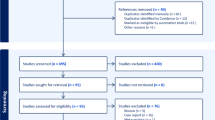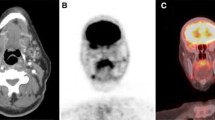Abstract
Purpose
Radiolabelled somatostatin (SST) analogues have proven useful in diagnosing tumours positive for SST receptor (SSTR). As different subtypes of SSTR are expressed on the tumour cell surface, the choice of appropriate therapeutic SST analogue is crucial. We evaluated the SSTR status of thyroid cancer patients who had signs of progressive disease comparing different SSTR ligands for PET imaging to evaluate possible further therapeutic options.
Methods
PET with 68Ga-radiolabelled SSTR ligands DOTA lanreotide (DOTA-LAN), DOTA-Tyr3 octreotide (DOTA-TOC) and 18F-FDG was performed in 31 patients with thyroid cancer (TC). These 31 patients comprised 18 with radioiodine non-avid differentiated TC (DTC) including 6 papillary TC (PTC), 8 follicular TC (FTC) and 4 oxyphilic TC (oxyTC), 5 with anaplastic TC (ATC), and 8 with medullary TC (MTC). The PET results were compared in a region-based evaluation.
Results
All patients underwent a PET study with 68Ga-DOTA-LAN, 28 patients with 68Ga-DOTA-TOC and 28 patients with 18F-FDG. A lack of SSTR expression was found in 13 of the 31 patients (42 %) with negative results with both SSTR tracers in 12 patients. Ambiguous results with both SSTR tracers were observed in one patient. High tracer uptake in SSTR PET images was seen in seven DTC patients (39 %; two PTC, three FTC, two oxyTC), in four ATC patients (80 %) and in six MTC patients (75 %). Lesions showing aerobic glycolysis on 18F-FDG PET were found in 24 of 28 patients (86 %) with corresponding positive results with 68Ga-DOTA-LAN in 35 % and with 68Ga-DOTA-TOC in 29 %.
Conclusion
The heterogeneous SSTR profile of TC tumour lesions needs to be evaluated using different SSTR PET tracers to characterize more closely the SSTR subtype affinities in patients with progressive TC in order to further stratify therapy with SSTR therapeutics.


Similar content being viewed by others
References
Schlumberger MJ. Papillary and follicular thyroid carcinoma. N Engl J Med. 1998;338:297–306.
Durante C, Haddy N, Baudin E, Leboulleux S, Hartl D, Travagli JP, et al. Long-term outcome of 444 patients with distant metastases from papillary and follicular thyroid carcinoma: benefits and limits of radioiodine therapy. J Clin Endocrinol Metab. 2006;91:2892–9.
Sherman SI. Thyroid carcinoma. Lancet. 2003;361:501–11.
Xing M, Haugen BR, Schlumberger M. Progress in molecular-based management of differentiated thyroid cancer. Lancet. 2013;381(9871):1058–69.
Ain KB, Taylor KD, Tofiq S, Venkataraman G. Somatostatin receptor subtype expression in human thyroid and thyroid carcinoma cell lines. J Clin Endocrinol Metab. 1997;82:1857–62.
Forssell-Aronsson EB, Nilsson O, Bejegård SA, Kölby L, Bernhardt P, Mölne J, et al. 111In-DTPA-D-Phe1-octreotide binding and somatostatin receptor subtypes in thyroid tumors. J Nucl Med. 2000;41:636–42.
Rodrigues M, Traub-Weidinger T, Leimer M, Li S, Andreae F, Angelberger P, et al. Value of 111In-DOTA-lanreotide and 111In-DOTA-DPhe1-Tyr3-octreotide in differentiated thyroid cancer: results of in vitro binding studies and in vivo comparison with 18F-FDG PET. Eur J Nucl Med Mol Imaging. 2005;32:1144–51.
Haslinghuis LM, Krenning EP, De Herder WW, Reijs AE, Kwekkeboom DJ. Somatostatin receptor scintigraphy in the follow-up of patients with differentiated thyroid cancer. J Endocrinol Invest. 2001;24:415–22.
Gabriel M, Froehlich F, Decristoforo C, Ensinger C, Donnemiller E, von Guggenberg E, et al. 99mTc-EDDA/HYNIC-TOC and (18)F-FDG in thyroid cancer patients with negative (131)I whole-body scans. Eur J Nucl Med Mol Imaging. 2004;31:330–41.
Waldherr C, Schumacher T, Pless M, Crazzolara A, Maecke HR, Nitzsche EU, et al. Radiopeptide transmitted internal irradiation of non-iodophil thyroid cancer and conventionally untreatable medullary thyroid cancer using [90Y]-DOTA-D-Phe1-Tyr3-octreotide: a pilot study. Nucl Med Commun. 2001;22:673–8.
Virgolini I, Britton K, Buscombe J, Moncayo R, Paganelli G, Riva P. In- and Y-DOTA-lanreotide: results and implications of the MAURITIUS trial. Semin Nucl Med. 2002;32:148–55.
Görges R, Kahaly G, Müller-Brand J, Mäcke H, Roser HW, Bockisch A. Radionuclide-labeled somatostatin analogs for diagnostic and therapeutic purposes in nonmedullary thyroid cancer. Thyroid. 2001;11:647–59.
Hofmann M, Maecke H, Borner R, Weckesser E, Schöffski P, Oei L, et al. Biokinetics and imaging with somatostatin receptor PET radioligand 68Ga-DOTATOC: preliminary data. Eur J Nucl Med. 2001;28:1751–7.
Virgolini I, Szilvasi I, Kurtaran A, Angelberger P, Raderer M, Havlik E, et al. Indium-111-DOTA-lanreotide: biodistribution, safety and radiation absorbed dose in tumor patients. J Nucl Med. 1998;39:1928–36.
Traub-Weidinger T, Von Guggenberg E, Dobrozemsky G, Kendler D, Eisterer W, Bale R, et al. Preliminary experience with (68)Ga-DOTA-lanreotide positron emission tomography. Q J Nucl Med Mol Imaging. 2010;54:52–60.
Petrik M, Knetsch PA, Knopp R, Imperato G, Ocak M, von Guggenberg E, et al. Radiolabelling of peptides for PET, SPECT and therapeutic applications using a fully automated disposable cassette system. Nucl Med Commun. 2011;32:887–95.
Siegel R, Miller K, Jemal A. Cancer statistics 2015. CA Cancer J Clin. 2015;65(1):5–29.
Kwekkeboom DJ, Reubi JC, Lamberts SW, Bruining HA, Mulder AH, Oei HY, et al. In vivo somatostatin receptor imaging in medullary thyroid carcinoma. J Clin Endocrinol Metab. 1993;76(6):1413–7.
Garin E, Devillers A, Le Cloirec J, Bernard AM, Lescouarc'h J, Herry JY, et al. Use of indium-111 pentetreotide somatostatin receptor scintigraphy to detect recurrent thyroid carcinoma in patients without detectable iodine uptake. Eur J Nucl Med. 1998;25:687–94.
Giammarile F, Houzard C, Bournaud C, Hafdi Z, Sassolas G, Borson-Chazot F. Diagnostic management of suspected metastatic thyroid carcinoma: clinical value of octreotide scintigraphy in patients with negative high-dose radioiodine scans. Eur J Endocrinol. 2004;150:277–83.
Smith-Jones PM, Bischof C, Leimer M, Gludovacz D, Angelberger P, Pangerl T, et al. DOTA-lanreotide: a novel somatostatin analog for tumor diagnosis and therapy. Endocrinology. 1999;140:5136–48.
Ambrosini V, Castellucci P, Rubello D, Nanni C, Musto A, Allegri V, et al. 68Ga-DOTA-NOC: a new PET tracer for evaluating patients with bronchial carcinoid. Nucl Med Commun. 2009;30:281–6.
Middendorp M, Selkinski I, Happel C, Kranert WT, Grünwald F. Comparison of positron emission tomography with [(18)F]FDG and [(68)Ga]DOTATOC in recurrent differentiated thyroid cancer: preliminary data. Q J Nucl Med Mol Imaging. 2010;54(1):76–83.
Mato E, Matías-Guiu X, Chico A, Webb SM, Cabezas R, Berná L, et al. Somatostatin and somatostatin receptor subtype gene expression in medullary thyroid carcinoma. J Clin Endocrinol Metab. 1998;83:2417–20.
Wang W, Larson SM, Tuttle RM, Kalaigian H, Kolbert K, Sonenberg M, et al. Resistance of [18F]-fluorodeoxyglucose-avid metastatic thyroid cancer lesions to treatment with high-dose radioactive iodine. Thyroid. 2001;11:1169–75.
Robbins RJ, Hill RH, Wang W, Macapinlac HH, Larson SM. Inhibition of metabolic activity in papillary thyroid carcinoma by a somatostatin analog. Thyroid. 2000;10:177–83.
Kohlfuerst S, Igerc I, Gallowitsch HJ, Gomez I, Kresnik E, Matschnig S, et al. Is there a role for sandostatin treatment in patients with progressive thyroid cancer and iodine-negative but somatostatin-receptor-positive metastases? Thyroid. 2006;16:1113–9.
Iten F, Muller B, Schindler C, Rasch H, Rochlitz C, Oertli D, et al. [(90)Yttrium-DOTA]-TOC response is associated with survival benefit in iodine-refractory thyroid cancer: long-term results of a phase 2 clinical trial. Cancer. 2009;115:2052–62.
Versari AL, Sollini M, Frasoldati A, Fraternali A, Filice A, Froio A, et al. Differentiated thyroid cancer: a new perspective with radiolabeled somatostatin analogues for imaging and treatment of patients. Thyroid. 2014;24(4):715–26.
Klein Hesselink EN, Steenvoorden D, Kapiteijn E, Corssmit EP, van der Horst-Schrivers AN, Lefrandt JD, et al. Therapy of endocrine disease: response and toxicity of small-molecule tyrosine kinase inhibitors in patients with thyroid carcinoma: a systematic review and meta-analysis. Eur J Endocrinol. 2015;172(5):R215–25.
Compliance with ethical standards
Conflicts of Interest
None.
Informed consent
This study was retrospective in nature and formal consent was not required. All patients gave written informed consent before undergoing each of the imaging modalities according to institutional guidelines.
Author information
Authors and Affiliations
Corresponding author
Rights and permissions
About this article
Cite this article
Traub-Weidinger, T., Putzer, D., von Guggenberg, E. et al. Multiparametric PET imaging in thyroid malignancy characterizing tumour heterogeneity: somatostatin receptors and glucose metabolism. Eur J Nucl Med Mol Imaging 42, 1995–2001 (2015). https://doi.org/10.1007/s00259-015-3114-6
Received:
Accepted:
Published:
Issue Date:
DOI: https://doi.org/10.1007/s00259-015-3114-6




